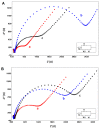Impedimetric Sensing of Factor V Leiden Mutation by Zip Nucleic Acid Probe and Electrochemical Array
- PMID: 32906640
- PMCID: PMC7559847
- DOI: 10.3390/bios10090116
Impedimetric Sensing of Factor V Leiden Mutation by Zip Nucleic Acid Probe and Electrochemical Array
Abstract
A carbon nanofiber enriched 8-channel screen-printed electrochemical array was used for the impedimetric detection of SNP related to Factor V Leiden (FV Leiden) mutation, which is the most common inherited form of thrombophilia. FV Leiden mutation sensing was carried out in three steps: solution-phase nucleic acid hybridization between zip nucleic acid probe (Z-probe) and mutant type DNA target, followed by the immobilization of the hybrid on the working electrode area of array, and measurement by electrochemical impedance spectroscopy (EIS). TArzhe selectivity of the assay was tested against mutation-free DNA sequences and synthetic polymerase chain reaction (PCR) samples. The developed biosensor was a trustful assay for FV Leiden mutation diagnosis, which can effectively discriminate wild type and mutant type even in PCR samples.
Keywords: 8-channel screen-printed electrochemical arrays; SNP; electrochemical impedance spectroscopy; zip nucleic acids.
Conflict of interest statement
The authors declare no conflict of interest.
Figures




Similar articles
-
ZNA probe immobilized single-use electrodes for impedimetric detection of nucleic acid hybridization related to single nucleotide mutation.Anal Chim Acta. 2019 Sep 13;1071:78-85. doi: 10.1016/j.aca.2019.04.036. Epub 2019 Apr 22. Anal Chim Acta. 2019. PMID: 31128758
-
Magnetic beads assay based on Zip nucleic acid for electrochemical detection of Factor V Leiden mutation.Int J Biol Macromol. 2019 Mar 15;125:839-846. doi: 10.1016/j.ijbiomac.2018.12.107. Epub 2018 Dec 13. Int J Biol Macromol. 2019. PMID: 30552928
-
Electrochemical Detection of Solution Phase Hybridization Related to Single Nucleotide Mutation by Carbon Nanofibers Enriched Electrodes.Materials (Basel). 2019 Oct 16;12(20):3377. doi: 10.3390/ma12203377. Materials (Basel). 2019. PMID: 31623126 Free PMC article.
-
A sensitive and label-free impedimetric biosensor based on an adjunct probe.Anal Chim Acta. 2013 May 7;776:11-6. doi: 10.1016/j.aca.2013.03.030. Epub 2013 Mar 21. Anal Chim Acta. 2013. PMID: 23601275 Review.
-
A review on impedimetric biosensors.Artif Cells Nanomed Biotechnol. 2016;44(1):248-62. doi: 10.3109/21691401.2014.942456. Epub 2014 Sep 11. Artif Cells Nanomed Biotechnol. 2016. PMID: 25211230 Review.
Cited by
-
Zip Nucleic Acid-Based Genomagnetic Assay for Electrochemical Detection of microRNA-34a.Biosensors (Basel). 2023 Jan 15;13(1):144. doi: 10.3390/bios13010144. Biosensors (Basel). 2023. PMID: 36671979 Free PMC article.
-
Recent Progress on Optical Biosensors Developed for Nucleic Acid Detection Related to Infectious Viral Diseases.Micromachines (Basel). 2023 Jan 23;14(2):295. doi: 10.3390/mi14020295. Micromachines (Basel). 2023. PMID: 36837995 Free PMC article. Review.
References
MeSH terms
Substances
Supplementary concepts
Grants and funding
LinkOut - more resources
Full Text Sources

